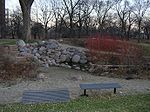Washington Park (Chicago park)
Washington Park | ||
MPS Chicago Park District MPS | | |
| NRHP reference No. | 04000871[1] | |
|---|---|---|
| Added to NRHP | August 20, 2004 | |
Washington Park (formerly Western Division of South Park, also Park No. 21) is a 372-acre (1.5 km2)
Planning
Washington Park was conceived by
When Olmsted first examined the property, he saw a field filled with bare trees and decided to maintain its character by creating a meadow surrounded by trees. His plan for the park called for sheep to graze as a means of keeping the grass short. Cornell convinced Olmsted to include sporting areas, although Olmsted wanted a more natural feel to the park, which included a 13-acre (53,000 m2) lake.[7] The Western division was renamed Washington Park in 1881.[6]

Olmsted designed the park to have two broad boulevards cutting through it, making it part of the
Construction
One of the earliest improvements was the "South Open Green", a pastoral meadow with grazing sheep, also used as a ball field. Architect
Usage
On December 6, 1879, former U.S. President
At the southeast corner of the park, at 61st and Cottage Grove, Washington Park Race Track operated between 1883 and 1905. It was one of the largest and grandest horse racetracks of its time. A nine-hole golf course was built in the infield and several of its buildings survive today as part of the Park District. This includes the stables used by Chicago Police at 58th and Cottage Grove. The racetrack closed after Illinois outlawed gambling, and the name was transferred to a second track in Homewood, Illinois.
The USA Cross Country Championships were held in the park in 1933, 1957, 1958, 1962, 1963, 1964, 1967, 1970 and 1972.[14]

Washington Park was a site of tension and conflict arising from the demographic changes resulting from the African American expansion into the neighborhood in the period following the
2016 Olympic bid
On September 21, 2006, Mayor
Additional details about the plan included new permanent hockey fields, use of Jones Armory, and new pedestrian juncture between the two halves of the park by tunneling part of Morgan Drive (55th).[20][21] A later December 2008 plan added the olympic swimming venue to the park.[22] The plan faced opposition from those holding the view that Washington Park's listing on the National Register of Historic Places could not have survived the execution of this Olympic plan. In addition to the opposition, the plan faced constraints because of the park's landmark status, which precluded federal money from being used to build a temporary stadium in the park.[20] The October 2009 decision to award the 2016 Summer Games to Rio de Janeiro halted these plans.[23]
Today
Washington Park is listed on the
Notes
- ^ "National Register Information System". National Register of Historic Places. National Park Service. March 13, 2009.
- ^ a b c d e Bachin, Robin (2005). "Washington Park (Park)". The Encyclopedia of Chicago. Chicago Historical Society. Retrieved October 22, 2007.
- ^ ISBN 0-7385-0716-4.
- ^ ISBN 0-7385-0716-4.
- ^ Encyclopedia of Chicago Map
- ^ a b c Duo Consulting (2006). "Washington Park". Chicago Park District. Retrieved January 2, 2007.
- ISBN 978-0-684-83138-1.
- ^ ISBN 0-226-31015-9
- ISBN 0-226-31015-9
- ISBN 0-7385-0716-4.
- ISBN 0-226-31015-9
- ISBN 0-7385-0716-4.
- ISBN 0-226-31015-9
- ^ "U.S. National Cross Country Champions" (PDF). therealxc.com. Retrieved September 16, 2018.
- ^ "Museum History". DuSable Museum of African American History. Retrieved January 25, 2010.
- ^ Hinz, Greg (September 20, 2006). "Daley sets site for Olympic stadium". ChicagoBusiness.com. Retrieved December 27, 2006.
- ^ Benjy (September 21, 2006). "New Plan for Olympic Stadium". Chicagoist.com. Archived from the original on October 19, 2006. Retrieved December 27, 2006.
- ^ Staff writer (September 20, 2006). "Daley Proposes Olympic Stadium To Be Built". CBS2Chicago.com. Archived from the original on September 30, 2007. Retrieved December 27, 2006.
- ^ Kamin, Blair (September 21, 2006). "Washington Park plan looks like a gold medal winner for the city". chicagotribune.com. Retrieved December 27, 2006.
- ^ a b "The proposal for Olympic 2016 facilities in Washington Park on Chicago's Mid-South Side and an historic Olmsted park with Community commentaries". hydepark.org. October 12, 2010.
- ^ For a photographic representation of the plan see Plan maps.
- ^ Spielman, Fran (December 12, 2008). "Taxpayers facing more Olympic risk: BIGGER GAMBLE". Chicago Sun-Times. Digital Chicago, Inc. Archived from the original on December 17, 2008. Retrieved December 31, 2008.
- ^ Macur, Juliet (October 2, 2009). "Rio Wins 2016 Olympics in a First for South America". The New York Times. p. A1. Retrieved January 24, 2010.
- ^ "Illinois - Cook County - Historic Districts". National Register of Historic Places. Archived from the original on May 16, 2008. Retrieved April 1, 2009.
- ^ Bachrach, Julia Sniderman (July 2, 2004). "National Register of Historic Places Registration Form: Washington Park" (PDF). United States Department of the Interior/National Park Service. Retrieved April 1, 2009.
External links
- Washington Park Maps
- Official City of Chicago Washington Park Neighborhood Map
- Chicago Park District: Washington Park
- The Washington Park Advisory Council's web site
- Washington Park Quality-of-Life Neighborhood Planning







